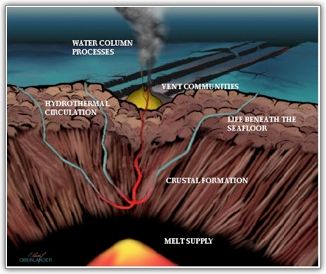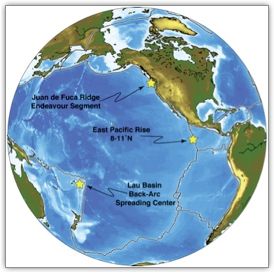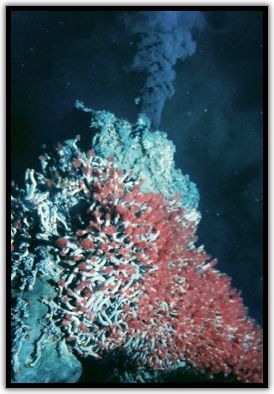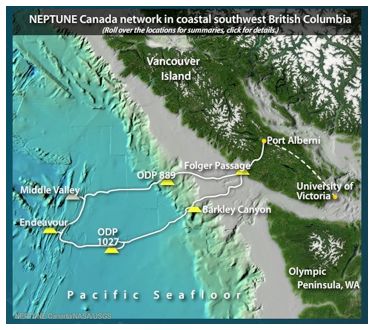
|
 |
 |
 |
The Endeavour seismic tomography experiment (ETOMO) experiment will test competing models for what controls the segmentation and intensity of ridge crest processes. Existing models are at odds on the scale of mantle and crustal magmatic segmentation, the distribution of hydrothermal venting with respect to a volcanic segment and the properties of the thermal boundary layer that transports energy between the magmatic and hydrothermal systems. The recent discovery of an axial magma chamber (AMC) reflector beneath the Endeavour segment of the Juan de Fuca ridge, as well as systematic along axis changes in seafloor depth, ridge crest morphology and hydrothermal venting provide an ideal target for testing models of the origin of segmentation at mid-ocean ridges. (Image: Dan Fornari, WHOI)
The ETOMO experimental design will investigate the 3-D structure of the crust and topmost mantle beneath the Endeavour segment, a RIDGE2000 Integrated Study Site (ISS). The scientific objectives are to: (1) Determine if the segmentation and intensity of the magma-hydrothermal systems at the Endeavour ridge are related to magma supply or to the magma plumbing between the mantle and crust, and (2) Constrain the thermal and magmatic structure underlying the Endeavour hydrothermal system in order to understand the patterns of energy transfer.
The results of our environmental research will also have other concrete science and societal benefits, including an improved understanding of the life cycle of deep-sea vents and of how the structure and hydration of oceanic crust contributes to earthquakes, tsunamis and volcanic hazards that threaten the Pacific Northwest (PNW). These points are explained further below.
The ETOMO expedition is collaborative between Professors Dr. Douglas Toomey and Dr. Emilie Hooft (University of Oregon) and Professor Dr. William Wilcock (University of Washington).
|
 |
 |
 |
 |
 | The location of the ETOMO experiment is the Endeavour segment of the Juan de Fuca ridge. This mid-ocean ridge segment is one of three integrated study sites for the NSF-funded RIDGE2000 program and it is a primary science node for NEPTUNE Canada. (Image: Donna Blackman, SIO)
|
 |
 |
 |
 |
  | Benefits to the conservation, protection and understanding of the Endeavour MPA:
|
 |
 |
 |
 |
 |
Deep-sea hydrothermal sites (i.e., black-smokers), which occur along mid-ocean ridges in the world’s oceans, result in significant heat loss from the Earth’s interior, influence the chemical composition of both seawater and the ocean’s crust and provide the chemical energy to support unique biological communities. These biological communities use novel metabolisms and enzymes that allow them to thrive in these extreme environments and have exceptional diversity. Understanding deep-sea vent systems may give us clues to how life evolved on Earth and elsewhere. Unlike other marine and terrestrial ecosystems, the hydrothermal vent communities at Endeavour and elsewhere along mid-ocean ridges are entirely dependent upon heat from a magma body within the oceanic crust as their primary source of energy.
A primary purpose of the Endeavour tomography experiment is to image the magma chamber(s) and heat sources that fuel the Endeavour vent fields. Precise images of the magmatic system will be used to develop predictive models of the subseafloor physical and chemical processes that give rise to and sustain the deep-sea vents and to advance our understanding of the life cycle of the vents themselves. Recent studies, for example, indicate that the robustness of the Endeavour vent fields is changing rapidly on the timescale of a few years. The results of the Endeavour tomography experiment are thus critical to our understanding of the stability of hydrothermal vent populations and warm water plumes in the area, to evaluating the importance of the MPA as a long-term reservoir for biodiversity and to making knowledgeable decisions regarding the conservation and protection of this and other deep-sea vent sites and ecosystems.
|
 |
 |
 |
 |
  | Benefits to Neptune Canada Cabled Observatory:
|
 |
 |
 |
 |
 |
The Canadian federal and British Columbia provincial government agencies (e.g. Natural Sciences and Engineering Research Council; British Columbia Ministry of Advanced Education; BC Knowledge Development Fund), Canada Foundation for Innovation, and CANARIE) have contributed >$100M CND in support of the Neptune Canada Cabled Ocean Observatory that establishes a high power and bandwidth cabled observatory at the Endeavour MPA sites. A major science theme for the Endeavour Sites includes understanding earthquakes and plate tectonics (http://neptunecanada.ca/about-neptune-canada/science/earthquakes-and-plate-tectonics.dot). As part of Neptune Canada, a seafloor seismic network will be deployed at this site that includes a broadband seismometer (360s - 50Hz), current meter, differential pressure sensor, strong motion accelerometer, and several short-period seismometers located in and proximal to the Mothra and Main Endeavour Hydrothermal Fields within the MPA. The Neptune Canada observatory at Endeavour will monitor the long-term, decadal-scale evolution of the vent fields and associated ecosystems.
Results from the Endeavour tomography experiment will provide a critical foundation to the Neptune Canada observatory within the Endeavour MPA because they will help inform Canadian scientists about the detailed structure of the oceanic crust and location of magma and heat sources beneath the Endeavour Segment. Data from the Endeavour tomography experiment will be fundamental to the interpretation of the multidisciplinary data that will be produced by the Neptune Canada cabled observatory.
|
 |
 |
 |
 |
  | Benefits to understanding geohazards in the Pacific Northwest:
|
 |
 |
 |
 |
 | The Pacific Northwest is vulnerable to earthquakes, tsunamis and volcanic eruptions, and this cruise will contribute to the scientific understanding of these hazards. The deep earthquakes of magnitude 6-7 that shake the populated regions of Puget Sound (e.g., the 2001 Nisqually earthquake; the 1965 Seattle Earthquake) are believed to be a result of the release of water from the hydrated oceanic crust as it descends beneath North America. This water ultimately leads to the explosive eruptions at Cascade volcanoes. The ETOMO experiment will contribute to our understanding of how and to what extent hydrothermal systems hydrate the oceanic crust. (Image: CEV, UW)
Furthermore, the best available science points to the region offshore of Oregon, Washington and British Columbia as being capable of generating both a magnitude 9 mega-thrust earthquake and a tsunami comparable in scale to the 2004 Sumatra earthquake, which killed ~300,000 people. Seismic studies of the Juan de Fuca plate allow us to better understand how its structure controls plate tectonic processes in the PNW. For example, regional variations in the structure and strength of the incoming plate may control the nucleation of mega-thrust earthquakes and on-land volcanic activity. ETOMO will characterize the structure of volcanic systems along the Juan de Fuca ridge and thus investigates the formation of regional-scale structures in the Juan de Fuca plate.
|
 |
 |
|
 |




